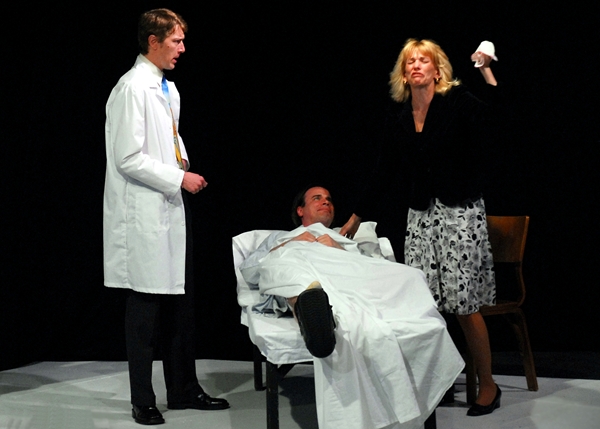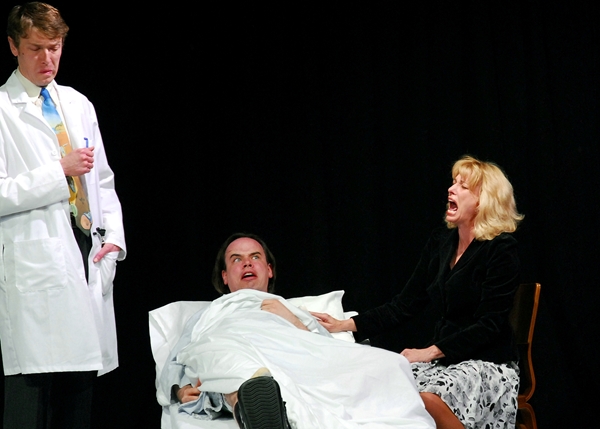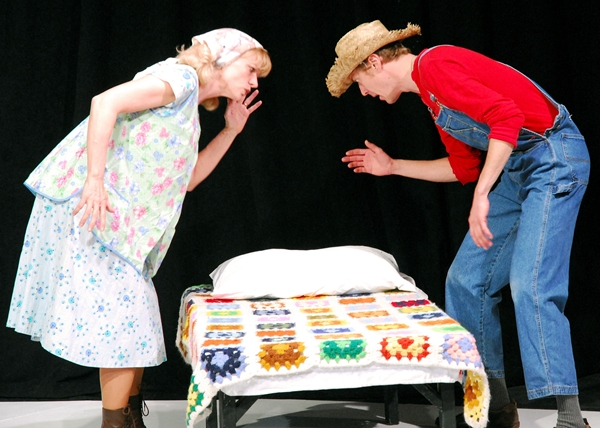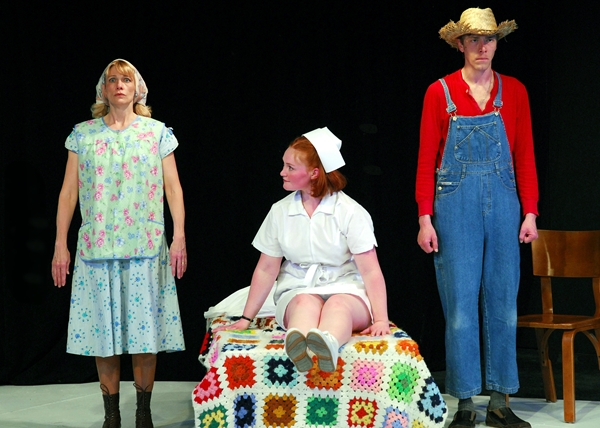There are few things that signal spring as brilliantly as the Philadelphia Flower Show. I’m planning to arrive one afternoon this week only 90 minutes after leaving New York City by bus. I’ve made the trek each year for several years, but didn’t last year because the day I’d set aside turned out to be the worst travel day of the year in New Jersey. Blizzard conditions lowered the speed limit to 20 mph on the New Jersey Turnpike that afternoon. A big disappointment. Understand that normal snow falling, even pouring rain, is no problem, as the Convention Center is only a couple of blocks from Philadelphia’s Greyhound station. Never been? You should go! This year’s theme is Passport to the World, and the show runs through next Sunday. Here are some of the visions I saw in 2007.

The show’s theme in 2007 was Ireland and its gardens. Each show has acres of displays by landscape firms from around the country, every one showing creative ideas. Above is a simple recirculating fountain with a totally natural look.
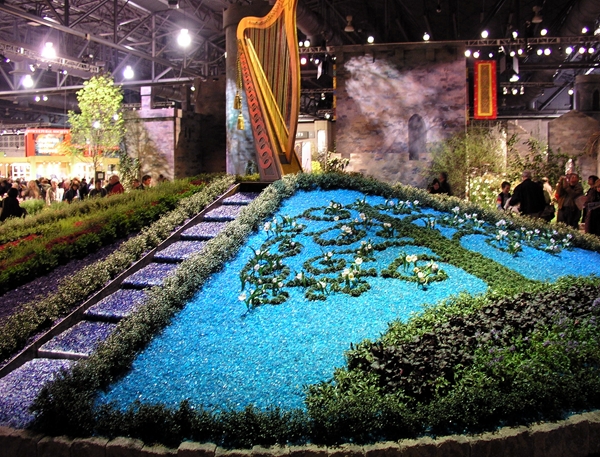
This massive display showed what can be done in the garden with recycled glass.
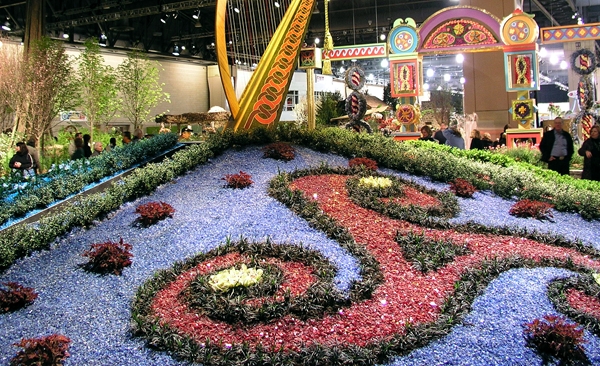
The harp and its mound greeted attendees upon entry, giving plenty of punch.
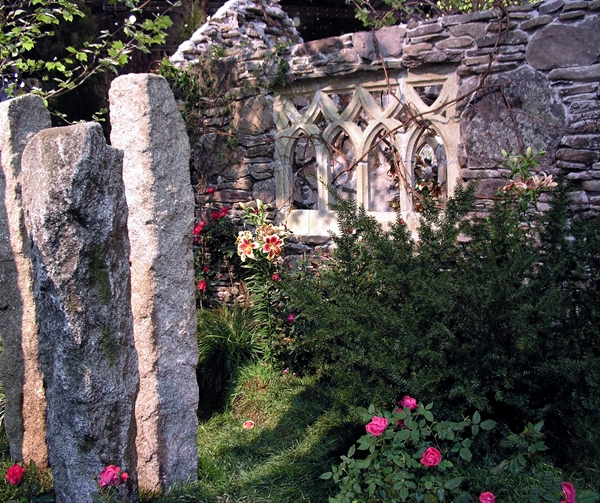
One of the most exquisite big displays was a stone church ruin with a rose garden.
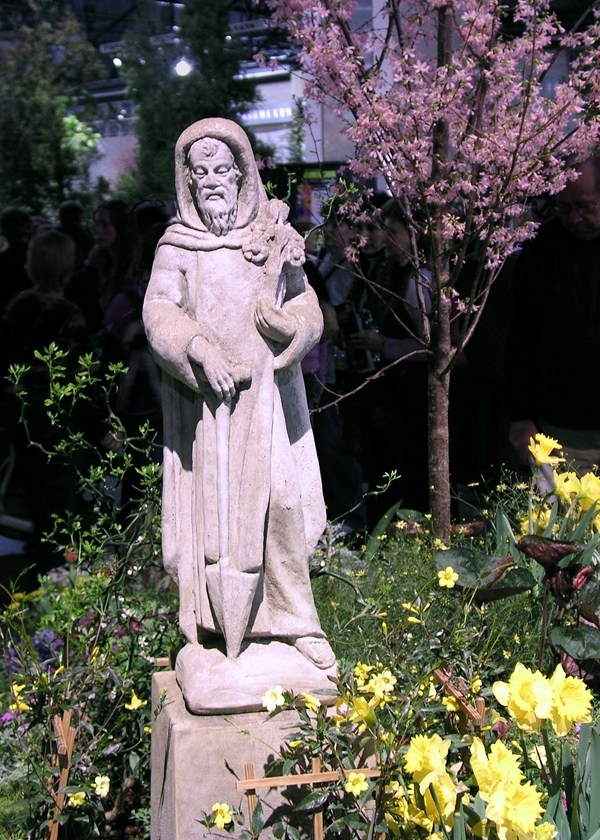
Saint Fiacre is the patron saint of gardening. He left Ireland in the 7th Century for France, where he joined a monastery. Granted a swatch of forested land, he asked for open land, and the legend says when he was told he could have as much land as he could till in one day that trees and bushes miraculously uprooted everywhere he touched the soil with his spade.
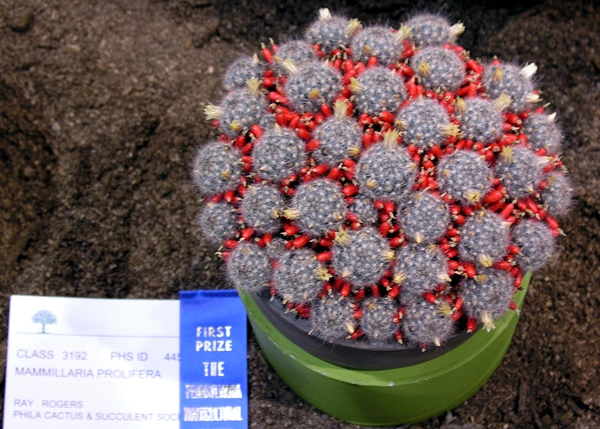
I’m including this for my friends who grow cactus. Yes, there’s a Philadelphia Cactus and Succulent Society. A good bit of the show is about competitions for best specimens, best arrangements, best table decorations, best room decorations, best miniature displays, etc. To be recognized by the judges of the Pennsylvania Horticultural Society is a great honor, and the organization works every day of the year in schools and in public education. Many displays teach conservation. The annual Flower Show is only one of the Society’s major activities.

Another winner. There’s always a plant of a kind you’ve never seen before.

And there are always orchids of surpassing beauty.
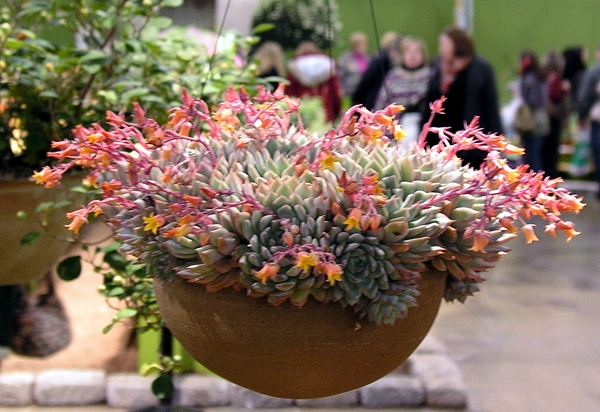
The individual plants that make the cut and are displayed can be viewed up close.
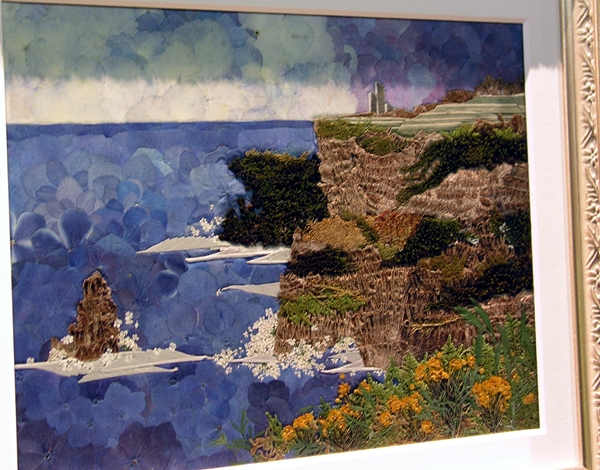
There’s also a competition for decorative arts utilizing plant materials, so there are many framed examples of pictures pieced together with petals and fibers.
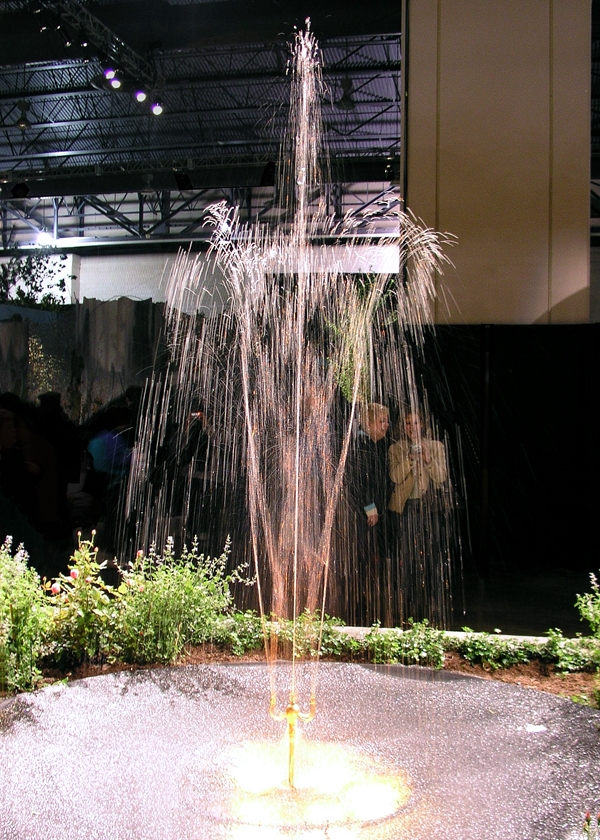
The view behind this shimmering fountain gives a sense of the size of the exhibition hall.
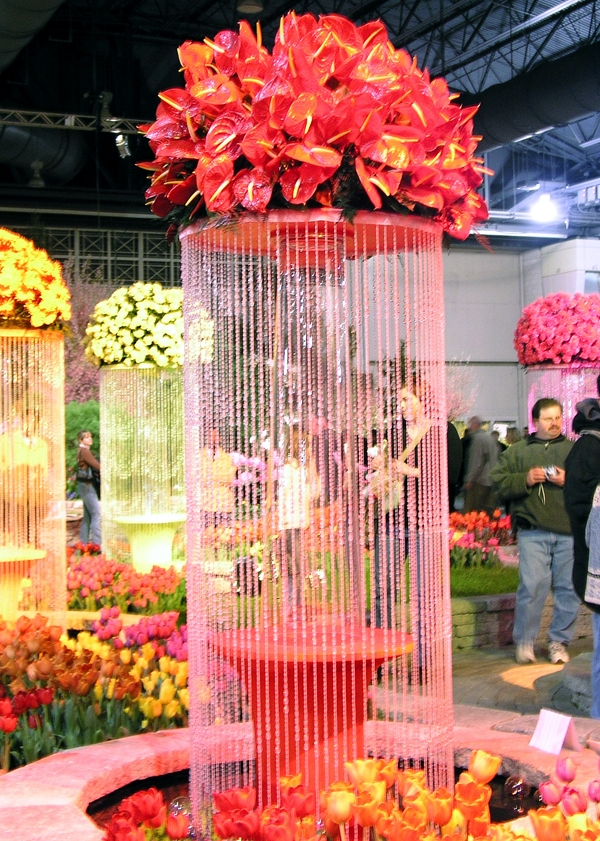
Too over the top for your taste? Keep moving. Something pleasing is just steps away.

Perhaps a quaint Irish cottage with a splashing waterfall.

Wouldn’t you love a garden like this to welcome you home? It won a big silver cup.
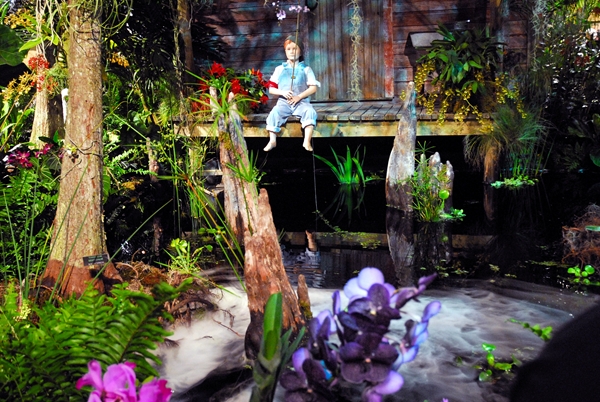
So, the first of three last photos — from 2008! The theme was Jazz and New Orleans, to give us a reminder of all the heritage that Hurricane Katrina threatened. This bayou scene had swirling fog moving on the water below the mannequin.
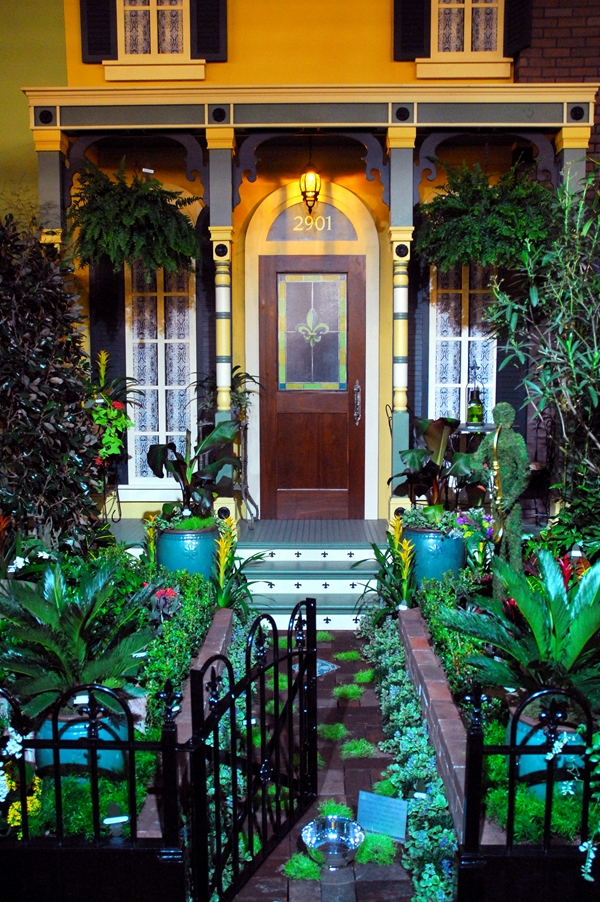
A silver bowl went to this New Orleans front yard display.
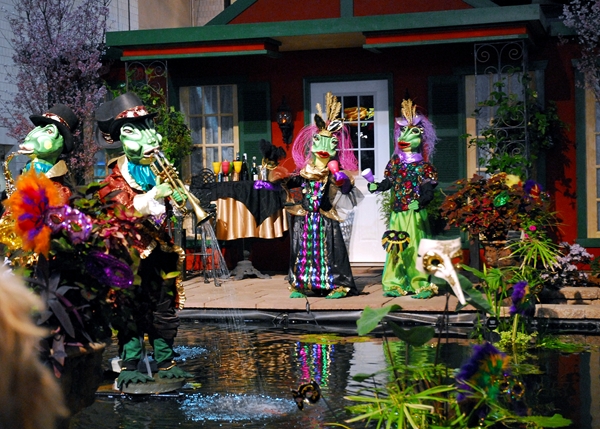
Frogs in their finery. Perhaps now you understand why I like to spend a late winter day in Philadelphia each year.
I had lunch at a lovely Turkish restaurant on the Upper East Side the other day with Sheila Simpson. I always describe her to friends as “my friend who’s a concert pianist,” hoping they’ll be as impressed as I always have been. Sheila and I have known each other since 1973, and share that special bond that New Yorkers have when we’re non-natives but know this is the only place for us to be. Sheila started life in Belzoni, Mississippi, where her mother ran the local dance school, and she was a child prodigy, playing her first solo piano recital at 11 and performing as a soloist with three different orchestras by age 15. A graduate of the University of Alabama, she received her master’s degree in piano performance from the Manhattan School of Music, graduating with honors. It was sometime after that, during the period she worked as a rehearsal pianist with the Alvin Ailey Dance Company, that we got to know each other. She was at that time studying with Arminda Canteros, a much-loved Argentinian piano teacher whose playing made tangos a permanent part of my music appreciation. One of Arminda’s concerts at Alice Tully Hall in the ’70s was one of the highlights of my life, and I’ll always thank her for turning me on to 20th century Spanish and Latin American music. I love it when Sheila plays anything by Ginastera.
Over the years, Sheila has performed at Merkin Hall, in the Lincoln Center neighborhood, in 2001, and at Princeton Theological Seminary in 2004. Both recitals are available on CDs through Sheila’s website, SheilasPiano.com. She’s performed at the United Nations, and around the world. In the past few years I’ve also heard her perform two recitals in the gallery at Tenri Cultural Institute on West 13th Street, presented by the Leschetizky Association, which was founded in 1942 by pupils of Theodor Leschetizky (1910-1915) to perpetuate his memory. He was one of the founders of the St. Peterburg Conservatory of Music, one of his greatest pupils was Paderewski, and one of his famous sayings was “No art without life, no life without art.” Sheila belongs to the Association, and passes along her own knowledge of being a virtuoso to her many students. A musical life is a rich one, and one that keeps on giving, generation after generation.
It was to deliver a few prints I’d made of the picture below, which I snapped during the last round of applause at last May’s recital at Tenri, that took me to the Upper East Side the other day.
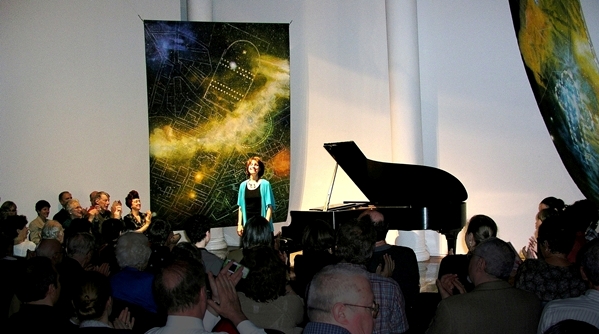
Sheila and I did studio portrait session last fall, in preparation for this year’s round of concerts. Here are some of the results.




In October, Sheila played Saint-Saens’ 2nd Piano Concerto in a concert with the Pine Bluff (Arkansas) Symphony, and because most of her New York friends couldn’t attend, she invited us to either of two preparation runthroughs she scheduled in one of the rooms upstairs at Steinway Hall, on West 57th Street. A pianist friend of hers, Francisco Miranda, played a transcription of the orchestra’s part while Sheila played the piano solo she would perform a few days later. Three movements, each very different, going as she said in the introduction “from Bach to Offenbach” in style. Only one melody in the whole thing that I recognized, but enjoyable for this non-classical non-musician’s ear and interesting enough to hear again sometime.
Lighting in the room was difficult, with strong light reflected in from the street through a big window and the room otherwise lighted with harsh florescents in two colors beaming down from rows of old factory-like fixtures. But I got this shot of Sheila and Mr. Miranda after they entertained us.
I always feel very priviledged when I hear Sheila play because she really puts the music across, producing it with a directness and intimacy — and obvious dexterity and command, almost always playing even the most complicated pieces from memory — but with no “look at me” ego thing going on. Sheila simply shares her love of music and her gift for performing it, and every listener feels it and learns. One of the glorious pieces I’ve heard her play several times is an arrangement for solo piano of Elgar’s “Nimrod” from the Enigma Variations that her husband Tom adapted for her as a gift. I can’t imagine what it must be like to be one of Shelia’s piano pupils trying to learn to play and reflect her high standards. But of course not everything is as easy as taking a good picture of an attractive woman.

While selecting photographs to show in the 2009 Vital Voices exhibition in the Jersey City Artists Studio Tour, the influence of three master photographers seemed obvious. I’ve loved their work for decades, so I wasn’t surprised. There’s not a photographer alive whose vision has not been influenced, either directly or indirectly, by their ways of seeing.
“The Quartzsite Beauty Salon, Quartzsite, Ariz.” – The town of Quartzsite, pop. 3,354, is in western Arizona near the California border. A popular RV camping ground for winter tourists, its gem and mineral sellers and more than a dozen general swap meets attract more than a million people a year to the only town on the interstate between Phoenix and California. It was a bright February day when I stopped there for lunch at a just-the-basics restaurant, and across the street was a beauty parlor waiting for business to walk through its door.

Revered for finding quiet beauty in unadorned people and small-town architecture, Walker Evans was born into wealth and was educated at Phillips Academy and Williams College before dropping out and spending a year in Paris, then joining the New York art crowd. He is best known for documenting rural life and poverty during the Great Depression for the Farm Security Administration. His book with the author James Agee, “Let Us Now Praise Famous Men,” focused on three sharecropper families in southern Alabama, was published in 1941. His 1938 show at the Museum of Modern Art was the first the museum devoted to a single photographer; it staged another comprehensive exhibit in 1971. Walker Evans died in 1975, having spent several years teaching at Yale after writing and editing for 20 years at Time and then Fortune magazine. Except for 1,000 negatives owned by the Library of Congress and in the public domain, the Metropolitan Museum of Art owns the copyright on all of his works in all media. He is quoted as saying his goal as a photographer was to make pictures that were “literate, authoritative, transcendent.”
“Calla Lilies, San Francisco, January 2009” – It was raining when my plane landed and in my first walk around my friends’ neighborhood I spotted these callas, still wearing raindrops, growing in a cement trough squeezed between the driveway and front staircase of an otherwise ordinary home.

Considered the quintessential woman photographer of the 20th century, Imogen Cunningham’s first job out of college in 1907 was making platinum prints in the darkroom of Edward S. Curtis. The photographer whose work documented the lives of the various North American Indian tribes operated one of the most successful portrait studios in Seattle. Cunningham’s independent college study had focused on chemistry and optics, as photography was such a young medium that there were no courses discussing “vision” or “expression.” It was Pictorialism – doing in dreamy, soft-focus photos what painters had been doing – that was the dominant photographic style. Always on the cutting edge even as she raised three children and operated her own successful Seattle portrait studio, Cunningham by the early 1930s was a leading Modernist photographer, a co-founder of the Group f/64, which valued sharp focus and helped bury the Pictorialist style, and her iconic studies of magnolia blossoms and other flowers, as well as nudes, movie star photos for Vanity Fair, and industrial landscapes, moved the medium during the 1920s, 1930s and 1940s. In 1945, Cunningham accepted a teaching position in the first fine art photography department at the California School of Fine Arts, and continued to take photos until shortly before her death at 93 in San Francisco in 1976.
“The Pennsylvania Woods” – In my photo shot from a walkway at Falling Water, the Frank Lloyd Wright house, we are looking down, across and up into a wilderness area that is under the protection of the Western Pennsylvania Conservancy.

From the 1940s through the 1970s, Eliot Porter’s nature photography set new standards in color photography, and in presenting the natural world, at a time when most “serious” photographers were limited to black and white and color was considered “too literal.” Porter’s entire body of work, and in particular his first book for the Sierra Club, “In Wilderness Is the Preservation of the World” (1962) with text from Henry David Thoreau, gave early momentum to the modern conservation movement. Porter died at age 89 in 1990, and bequeathed his professional archives, containing 10,000 prints, 84,000 color slides and transparencies, and 4,400 black and white negatives, to the Amon Carter Museum in Fort Worth, Texas. A biography and a review of a book about Porter can be found here.
I’m pleased to learn that a play I’ve enjoyed twice during staged readings will be given a full production in fall 2010.
I was curious but had no high expectations when I arrived at the Hoboken Historical Museum last fall for a staged reading, presented by gaia studio, of “The Flora Dora Girls Weekly Sewing Circle.” I know some of the actresses who would be performing, and knew their enthusiasm about bringing life to this previously unproduced play by the late Louis LaRusso II, a Hoboken playwright who received Tony and Drama Desk best play nominations in 1976 for “Lampost Reunion.” That play told of some old pals drinking the night away with their famous singer friend (Frank Sinatra) after he does a show at Madison Square Garden. Word of mouth was that “Flora Dora Girls” was a Hoboken “Steel Magnolias” set in a past that’s largely gone.
Part of my curiosity came from having edited so many Jersey Journal obituaries in the 1980s and ’90s for Italian-American matriarchs who’d worked in sewing factories in Hoboken, Weehawken, Union City, West New York. Each woman’s life had been different, of course, but the obit facts hardly varied: Born in a little town in Italy, came to America as a girl or a wife in the 1920s, worked in a coat or dress factory for 20, 30, even 40 years, the factory’s name now forgotten, not important, but if she had been a “floor lady” who oversaw production, that was always worth noting. Many times a surviving child or grandchild had earned a Dr. or other title to put in front of their name or added an Esq. after it. Sometimes the woman had no survivors, at least in America. Fewer of these obituaries ran with each passing year; very few of these women are living today. All had built America, and done so in sweatshops doing boring work day after day, year after year, so their children could have better lives.
So it meant a lot to me, and to many in the Historical Museum audience who could remember these little old women who dressed mostly in black, that LaRusso’s play, set in the mid-1960s, brings their stories and passions to vivid life. As the producers observe, the characters “come together for a weekly sewing circle, the one place where they don’t need to be ‘ladies.’ They sew, gossip, laugh, cry, fight, curse, ask big questions, tell great stories and bond – like a fist!” By turns dramatic and hysterically funny, “The Flora Dora Girls Weekly Sewing Circle” is a human comedy, richly observed, with emotions and dialogue that pre-date political correctness.
It was fun to revisit “The Flora Dora Girls” on Sept. 26 when it was again performed as a staged reading, with many new faces in the cast, and this time at the Monroe Arts Center in Hoboken. Directed and edited by Taylor Keith, produced by Lillian Ribeiro, featuring Susan Bucci, Eileen Gaughan, Domenica Galati, Angela Kariotis, Sheila Mart, Ellen O’Neil, Florence Pape, Chelsea Lee Richardson, Angela Sharp, Trish Szymanski and Eva Visco. With judicious cuts, the play did seem tighter the second time around. I look forward to seeing it performed on a set with costumes and props.
“The Flora Dora Girls Sewing Circle” is an ensemble work, but Florence Pape had the leading role. She gave what I call a “whammo” performance last year, and she was in top form this year as well. Below is one of the faces Florence showed me in my studio. I applaud her every chance I get.

Saturday night in Hoboken. Art time. Party time. And I was in the mood for both, having spent all afternoon staring at only three my own photos in Photoshop and learning new moves and tools through trial and error with a good friend who’s slightly more proficient. So I made my way down to the opening reception for “I Love My Life,” a major fall group art show at the Eureka Art Gallery, 259 First St. (Park-Willow), accessible for the night through the rear garden courtyard (pretty twinkling lights) around the block on Newark Street.
Not many photographs up, but plenty of eclectic art created by 35 artists in many media. Roland Ramos, a mover and shaker in the Hoboken art scene, put it all together. Lovely space, as you’ll see below.
In his intro to the show Roland recalls how he shared with a dispirited woman friend going through difficult times that her new mantra should be “I Love My Life,” and how she should keep saying it “until it says you.” This is a very wise idea. Everything in the show is tied to this mantra “I Love My Life.” Positivity is indeed what we need in bad times, in fact at all times. Be here now was a theme of my Saturday.
Of course I schmoozed with some Jersey City art scenesters, and took snaps as I headed home. Didn’t get names. But we’ll meet again. Everyone’s looking forward to the Jersey City Art Studio Tour on Oct. 3 and 4, when 600 artists’ works will be on view in dozens of galleries and public spaces and the Downtown Jersey City art scene will be rocking. I’ll have three of my photos in a group show. I love my life.
Roland’s I Love My Life show, open Monday through Saturday from 9 a.m. to 6 p.m., will be on view through Saturday, Oct. 10, and have a closing reception that night beginning at 7 p.m.
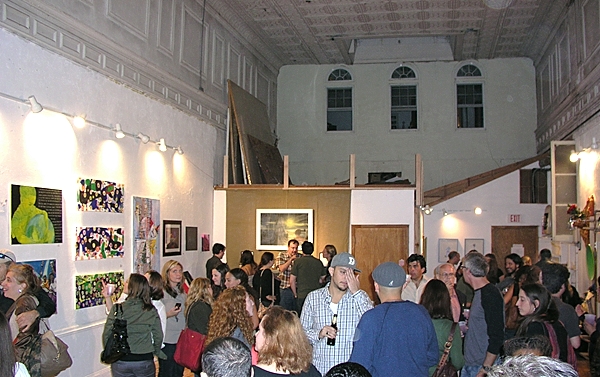
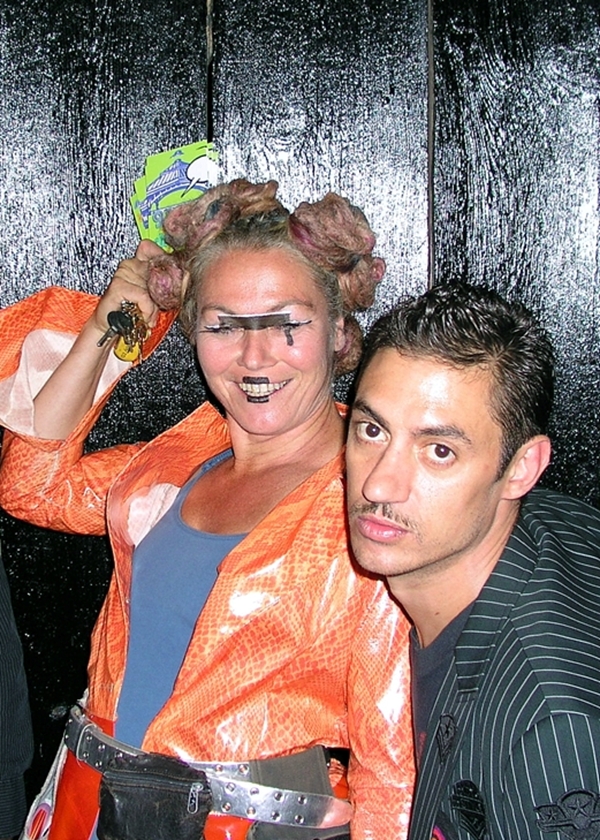
This is not a political blog; you’ll have to go elsewhere for that. But I find this odd photo says a lot and I’m showing it. The very hour I saw it in the viewfinder, while relaxing on a bench on Washington Street, which is Hoboken’s main drag, the candidates for mayor in the upcoming special election were playing beat the clock in delivering their nominating petitions to the County Clerk’s Office in Jersey City. The deadline was 4 p.m.
A little background: Hoboken is having its third mayoral election of the year because the cute 32-year-old lawyer most recently elected mayor resigned after only a month in office. He was one of 44 people, three of them mayors of New Jersey municipalities, arrested on corruption charges in late July. Charged with accepting $30,000 from a “cooperating witness” secretly working a sting operation for the FBI, and having been caught on tape saying some very unbecoming things over dinner in a diner just before allegedly taking some cash in an envelope as he and the “cooperating witness” parted in the parking lot (New Jersey’s image to the rest of the world), the photogenic young mayor’s face was prominent in newspapers from coast to coast. The “reform” candidate he had beaten by a few hundred votes in the June runoff is now serving as acting mayor. Both were on the City Council, and as council president she stepped into the Mayor’s Office when he stepped out. She’s now running in the special election, as is another councilwoman whose “reform” credibility has been questioned because she allegedly forged a secret alliance in the May election with another council member, who’s considered to represent the old “business as usual” Hoboken. His father, who served as mayor for most of the Nineties, did prison time after an earlier scandal involving developers and bribes.
So did the two ladies meet the 4 p.m. filing deadline to quality for the November ballot? The county clerk has been saying yes, but another candidate — herself a former Hoboken municipal court judge – says no, that the acting mayor filed her petitions a few minutes after the hour and should be stricken from the ballot. This “is it a mountain or a molehill?” dispute, which involves time stamps on documents and disputes over notarized signatures, seems headed to court. Meanwhile, another candidate who’s been on the council and school board before, and has been serving on the local sewer authority board for 22 years, is also running, along with a few other contenders, and no one is talking, or being asked, about any real issues.
The current turmoil and fingerpointing is nothing new. Last year’s big news was that the City Council refused to pass the budget until way past the legal deadline, blaming the lame duck mayor for keeping the council in the dark as to its contents until the last minute, when his familiar budget balancing tricks were seen not to have worked. That mayor in turn blamed the council for not going along and doing their legal duty to pass it. So the state government stepped in and appointed a fiscal monitor, who found the budget had been being “underfunded” for several years and promptly raised Hoboken’s city taxes 47 percent, later adjusted down to 23. Ouch and groan!
Then came the May mayoral election, with a crowded field and all the candidates claiming to have “new answers” to “old problems.” Then the June runoff with the narrow results, then the July corruption arrests and the mayor’s resignation, then a relative quiet August and now a September that’s awakened simmering ambitions all around. The special election is being held the same early November day New Jersey will elect its governor for the next four years, which means Republicans in Hoboken will be sure to vote, as the GOP candidate for governor actually appears to have a chance of unseating the millionaire Democrat (who lives in a Hoboken penthouse, built on the site of the old Maxwell House coffee plant) now winding up his first term. This means some Hoboken voters who couldn’t be bothered to vote in a city election may come out. And this GOP candiate is running on an anti-corruption platform, having sent scores of politicians to prison on corruption charges (including the above mentioned Hoboken councilman’s mayor daddy) during his tenure as the Bush-appointed U.S. attorney for New Jersey. Personally, I don’t think the state’s voters would be wise to hand over the governor’s job to someone who’s never had responsibility for running anything more complicated than an office full of prosecutors and assistant prosecutors, but despite having his own ethical lapses like being stopped speeding in an unregistered vehicle and giving a soon-to-be-former subordinate a $46,000 personal loan and not declaring the interest as income on his income taxes, having “corruption fighter” attached to his name may just do the trick.
My perennial questions: Can any of these people add? Can they balance municipal budgets without tricks like selling this or leasing that? Can they work together for what used to be called the common good?
The only thing I’m sure of is that there are clouds over Hoboken these days, and not the fluffy white kind.
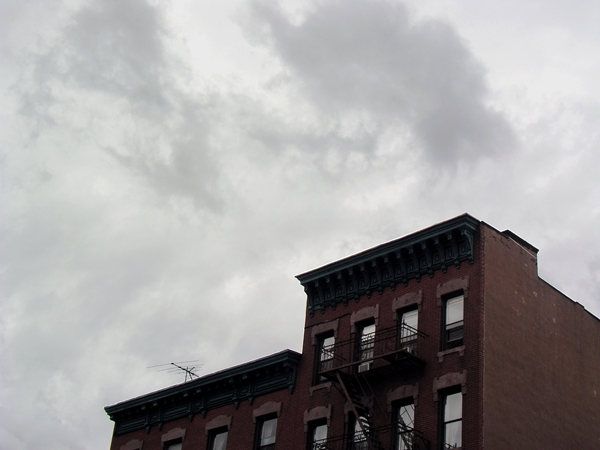
Maybe it’s because I grew up in Kansas, where it is the state flower, but I love every sunflower I see. And yet I’ve never tried to grow one; there’s no spot in my garden that’s right. Luckily, Jersey City Heights has lots of sunny front yards where they do grow tall. Just yesterday, I found there’s a 6-footer in front of a house across the street. Voila! Does seeing it make you as happy as it does me?
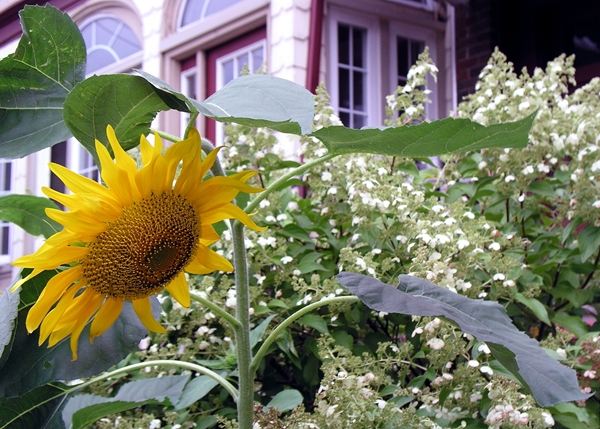
What casting directors and agents want to see nowdays is not necessarily the one perfect headshot, a mutual friend was explaining as I started taking pictures of Kathi Carlson a couple of summers ago. The people doing the hiring today want to see all the characters you can play, this actor and model said, and you need a selection of good shots so you can present an appropriate image for whatever part you’re seeking. Glossies with resumes on the back are still a necessity, but actors now are submitted for work with electronic images e-mailed to decision makers whose desks may be across town, or across the globe.
We were working with the available light streaming through Kathi’s living room windows, which was abundant (though variable, due to clouds, and eventually fading as the sun moved), and added fill light from incandescent bulbs in several lamps with their shades removed. I’ve always been comfortable using improvised lighting; it’s far preferable to flash-burning people’s faces. And digital cameras get better results with it than film cameras ever did.
As our friend Gary worked to call forth all the personas Kathi might take on for a stage play or a movie or commercial, I learned a lot about collaborating with performers. Gary and Kathi had just finished taking an acting class together, and with trust, trickery and a few acting exercises that afternoon we produced more than a dozen usable photos that suggest Kathi’s range. She was set to look for work. It was about that time that she quit an office job in the suburbs to put her energy into pursuing a show business career. It’s all paid off.
Flash forward two years, and Kathi’s been in one theater or film production after another in and around New York, and I’m now lighting my subjects with synced strobes that give consistent results frame after frame in my own well-equipped studio. And the trust and tricks still work their magic. Thanks Gary!
Last spring, Kathi hilariously played an android actress cast in TV soap operas and corny frontier family dramas in Alan Ayckbourn’s early-80s satiric comedy “Comic Potential.” (pictures way below).
Kathi has just been cast as Irina Arkadina in a new Americanized adaptation of Chekov’s “The Seagull” that will be performed in Manhattan by the Curan Repertory Company at The American Theater of Actors from Oct. 28 to Nov. 1. While Kathi often plays “mother” roles, Arkadina is not your run of the mill mom. I’m looking forward to seeing what she does as the big-ego stage actress reluctantly dealing with a neurotic son while trying to hold onto a fickle poet lover as well as her own fading stardom – a role of many nuances attempted by almost every great Russian, British and American actress of the past century.
Kathi Carlson is one of those performers who isn’t afraid of challenges, knowing how much they can stretch one’s talent and make the performing life exciting. Having gone skydiving for a recent birthday thrill, nothing will stop her from creating a memorable Arkadina this fall.



